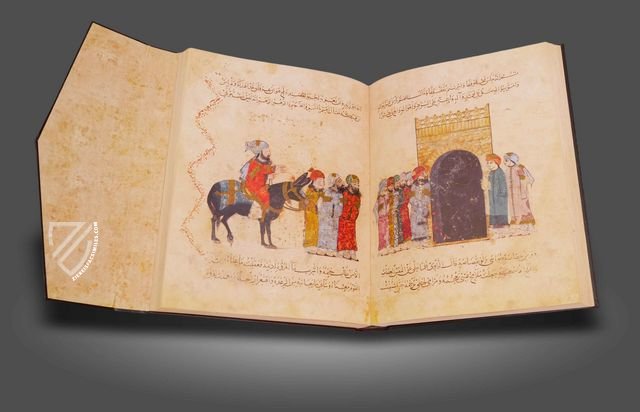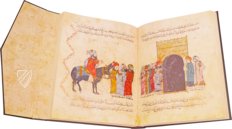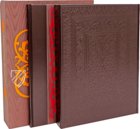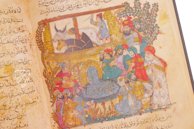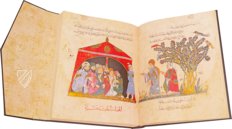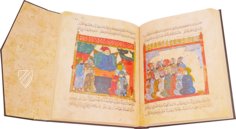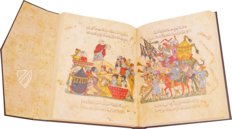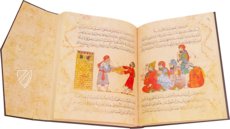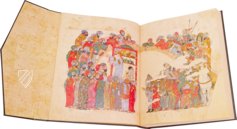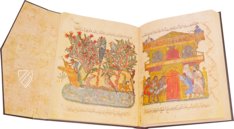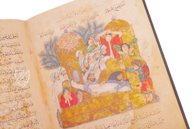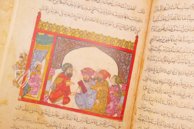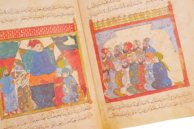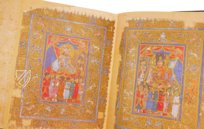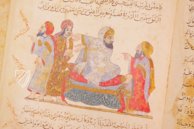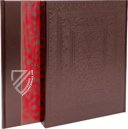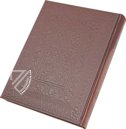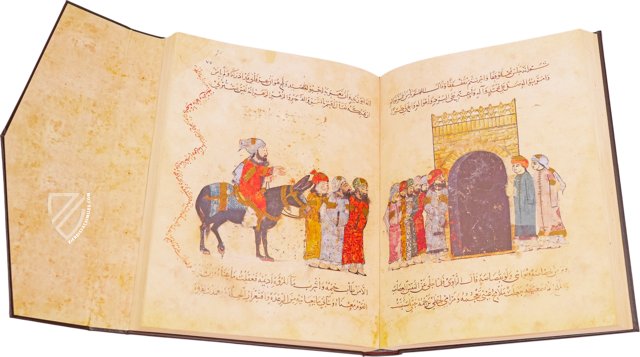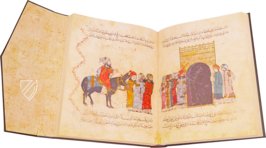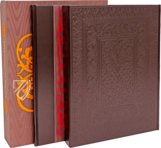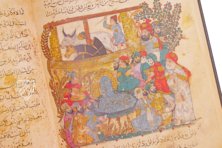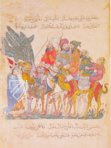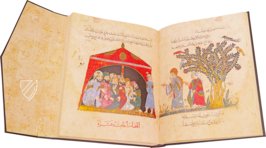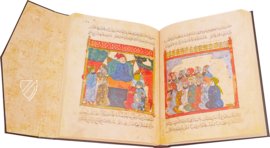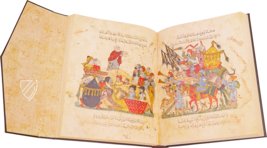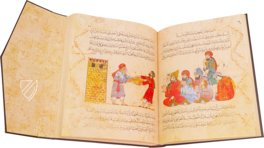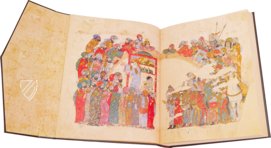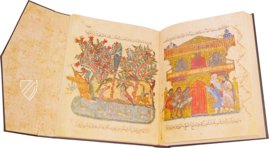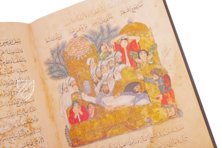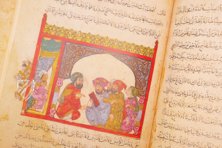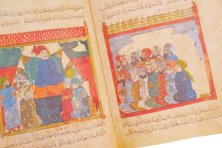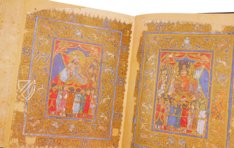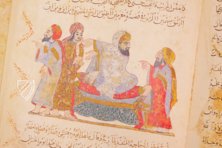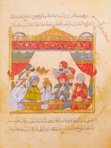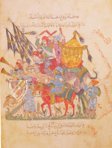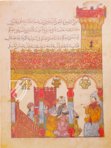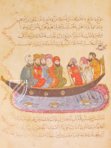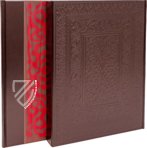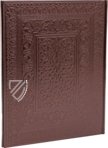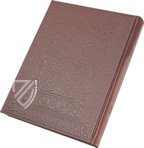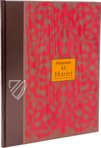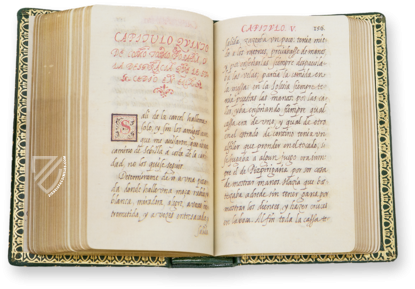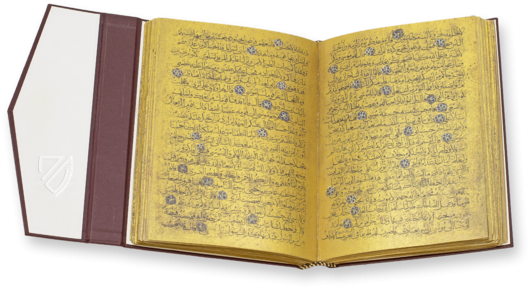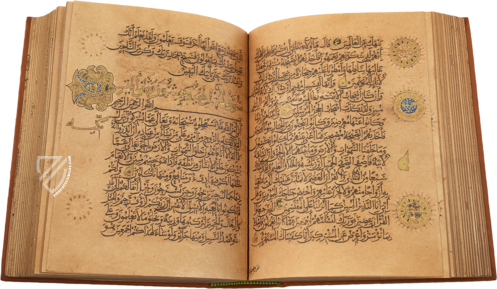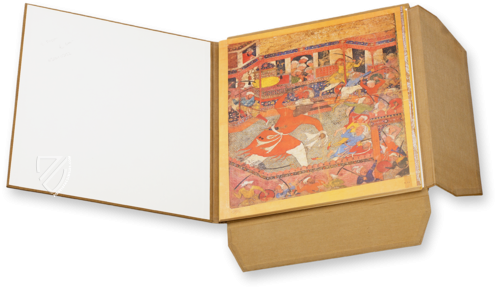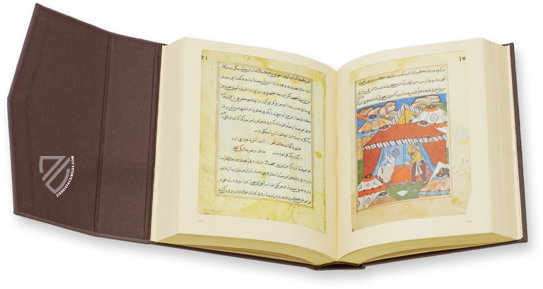Schefer Maqamat
(3,000€ - 7,000€)
This manuscript simultaneously represents the finest surviving specimen of the Maqamat Al-Hariri or The Assemblies of Al-Hariri and also features some of the most famous images of daily life in the medieval Islamic world. The work by Al-Hariri of Basra (1054–1122) consists of 50 short stories taking place across the Arab world. The specimen of the work at hand was transcribed and illustrated by Yahya ibn Mahmud al-Wasiti, a 13th century Iraqi painter and calligrapher. The 99 miniatures, rendered vividly but subtly with a diverse color palette and gold leaf, can be found in almost any book regarding medieval Islamic art and culture. The manuscript created by al-Wasiti in southern Iraq between 1236 and 1237 is unrivalled among the manuscripts created of this popular text, which appeared in manuscripts from as far away as Spain and continued to be presented in illuminated manuscripts until the 18th century.
Schefer Maqamat
Maqāmah is a genre of Arabic literature consisting of entertaining anecdotes about various roguish characters in the form of a “prosimetrum”, a combination of prose and verse, which blends social and moral commentary. The genre was initiated by Al-Hamadhānī (969–1008), an Arabic author who lived throughout modern Iran and Afghanistan, and is characterized by the refinement of the Arabic used to write it. Known simply as Al-Hariri of Basra, Abū Muhammad al-Qāsim ibn Alī ibn Muhammad ibn Uthmān al-Harīrī (1054–1122) is credited with creating the principle work of the genre, the Maqamat Al-Hariri or The Assemblies of Al-Hariri. It contains 50 short stories, each of which bears the title of the city where that story occurs. They are centered on two characters: Abu Zayd, a roguish Syrian from Saruj, and al-Harith, a naive travelling merchant and the narrator of the story, who meet at these various locales. The Bibliothèque Nationale in Paris is proud to house the finest specimen of this tale, which was created by Yahya ibn Mahmud al-Wasiti, a 13th century Iraqi painter and calligrapher.
A Beloved Arabic Text
The success of this text is due to the extraordinary language used by Al-Hariri, which is both sophisticated and playful: double and even triple puns, the unusual usage of words, and elaborate grammatical constructions demonstrate the Arabic language’s full range of expression. Such manuscripts were popular among the wealthy and educated laity of the Islamic world. The work’s popularity reached across the Mediterranean to Al-Andalus, Moorish Spain, where it was translated into Hebrew ca. 1218 by the poet and rabbi Yehuda Alharizi, who went on to write his own Maqamat, inspired to create a work that would elevate Hebrew to the heights reached by Al-Hariri. Illuminated Arabic manuscripts continued to be produced up to the 18th century, and the work has enjoyed translations into many languages. Produced in southern Iraq, then part of the Abbasid Caliphate, this most splendid manuscript of the work represents a high point of Islamic book art and is one of the most famous manuscripts of the entire Islamic medieval period.
Islamic Illumination at its Best
From 1236 to 1237, al-Wasiti transcribed and illustrated the work, which aside from its fine calligraphy, also distinguishes itself through both the quantity and quality of its adornment, consisting of 99 of the finest miniatures in all of Arabic art. Al-Wasiti’s miniature painting is of "outstanding quality with fine composition, expressive figures, and vivid but controlled colors" and provides readers with a "fascinating series of glimpses into and commentaries on 13th-century Islamic life." The imagery created by al-Wasiti appears in every book on medieval Arabic art and culture because of the realism with which they depict everyday life in the Islamic world, especially activities of the educated middle class such as travelling, visiting the library or mosque, appearing before a judge, or bidding at the slave market. They are as iconic for Arabic art as the miniatures of the Morgan Crusader Bible are for Christian art, with the notable difference that the latter is full of graphic depictions of war while the former neglects military matters altogether. The realism of al-Wasiti is blended with amusing depictions of people that border on caricatures and the scenes’ expressiveness makes it possible to interpret them without the text. A wide but subtle variety of colors and shades as well as the use of gold leaf rounds the appearance of this unparalleled work.
Codicology
- Alternative Titles
- Scherer Hariri
Maqamat Al-Hariri - Size / Format
- 334 pages / 38.0 × 27.0 cm
- Origin
- Iraq
- Date
- First half of the 13th century
- Epochs
- Style
- Language
- Illustrations
- 99 miniatures
- Content
- 50 short stories on everyday life
- Artist / School
- Yahya ibn Mahmud al-Wasiti
- Treatises / Secular Books
- Apocalypses / Beatus
- Astronomy / Astrology
- Bestiaries
- Bibles / Gospels
- Chronicles / History / Law
- Geography / Maps
- Saints' Lives
- Islam / Oriental
- Judaism / Hebrew
- Single Leaf Collections
- Leonardo da Vinci
- Literature / Poetry
- Liturgical Manuscripts
- Medicine / Botany / Alchemy
- Music
- Mythology / Prophecies
- Psalters
- Other Religious Books
- Games / Hunting
- Private Devotion Books
- Other Genres
- Afghanistan
- Armenia
- Austria
- Belgium
- Belize
- Bosnia and Herzegovina
- China
- Colombia
- Costa Rica
- Croatia
- Cyprus
- Czech Republic
- Denmark
- Egypt
- El Salvador
- Ethiopia
- France
- Germany
- Greece
- Guatemala
- Honduras
- Hungary
- India
- Iran
- Iraq
- Israel
- Italy
- Japan
- Jordan
- Kazakhstan
- Kyrgyzstan
- Lebanon
- Liechtenstein
- Luxembourg
- Mexico
- Morocco
- Netherlands
- Palestine
- Panama
- Peru
- Poland
- Portugal
- Romania
- Russia
- Serbia
- Spain
- Sri Lanka
- Sweden
- Switzerland
- Syria
- Tajikistan
- Turkey
- Turkmenistan
- Ukraine
- United Kingdom
- United States
- Uzbekistan
- Vatican City
- A. Oosthoek, van Holkema & Warendorf
- Aboca Museum
- Ajuntament de Valencia
- Akademie Verlag
- Akademische Druck- u. Verlagsanstalt (ADEVA)
- Aldo Ausilio Editore - Bottega d’Erasmo
- Alecto Historical Editions
- Alkuin Verlag
- Almqvist & Wiksell
- Amilcare Pizzi
- Andreas & Andreas Verlagsbuchhandlung
- Archa 90
- Archiv Verlag
- Archivi Edizioni
- Arnold Verlag
- ARS
- Ars Magna
- ArtCodex
- AyN Ediciones
- Azimuth Editions
- Badenia Verlag
- Bärenreiter-Verlag
- Belser Verlag
- Belser Verlag / WK Wertkontor
- Benziger Verlag
- Bernardinum Wydawnictwo
- BiblioGemma
- Biblioteca Apostolica Vaticana (Vaticanstadt, Vaticanstadt)
- Bibliotheca Palatina Faksimile Verlag
- Bibliotheca Rara
- Boydell & Brewer
- Bramante Edizioni
- Bredius Genootschap
- Brepols Publishers
- British Library
- C. Weckesser
- Caixa Catalunya
- Canesi
- CAPSA, Ars Scriptoria
- Caratzas Brothers, Publishers
- Carus Verlag
- Casamassima Libri
- Centrum Cartographie Verlag GmbH
- Chavane Verlag
- Christian Brandstätter Verlag
- Circulo Cientifico
- Club Bibliófilo Versol
- Club du Livre
- CM Editores
- Collegium Graphicum
- Collezione Apocrifa Da Vinci
- Comissão Nacional para as Comemorações dos Descobrimentos Portugueses
- Coron Verlag
- Corvina
- CTHS
- D. S. Brewer
- Damon
- De Agostini/UTET
- De Nederlandsche Boekhandel
- De Schutter
- Deuschle & Stemmle
- Deutscher Verlag für Kunstwissenschaft
- DIAMM
- Droz
- E. Schreiber Graphische Kunstanstalten
- Ediciones Boreal
- Ediciones Grial
- Ediclube
- Edições Inapa
- Edilan
- Editalia
- Edition Deuschle
- Edition Georg Popp
- Edition Leipzig
- Edition Libri Illustri
- Editiones Reales Sitios S. L.
- Éditions de l'Oiseau Lyre
- Editions Medicina Rara
- Editorial Casariego
- Editorial Mintzoa
- Editrice Antenore
- Editrice Velar
- Edizioni Edison
- Egeria, S.L.
- Eikon Editores
- Electa
- Emery Walker Limited
- Enciclopèdia Catalana
- Eos-Verlag
- Ephesus Publishing
- Ernst Battenberg
- Eugrammia Press
- Extraordinary Editions
- Fackelverlag
- Facsimila Art & Edition
- Facsimile Editions Ltd.
- Facsimilia Art & Edition Ebert KG
- Faksimile Verlag
- Feuermann Verlag
- Folger Shakespeare Library
- Franco Cosimo Panini Editore
- Friedrich Wittig Verlag
- Fundación Hullera Vasco-Leonesa
- G. Braziller
- Gabriele Mazzotta Editore
- Gebr. Mann Verlag
- Gesellschaft für graphische Industrie
- Getty Research Institute
- Giovanni Domenico de Rossi
- Giunti Editore
- Graffiti
- Grafica European Center of Fine Arts
- Guido Pressler
- Guillermo Blazquez
- Gustav Kiepenheuer
- H. N. Abrams
- Harrassowitz
- Harvard University Press
- Helikon
- Hendrickson Publishers
- Henning Oppermann
- Herder Verlag
- Hes & De Graaf Publishers
- Hoepli
- Holbein-Verlag
- Houghton Library
- Hugo Schmidt Verlag
- Idion Verlag
- Il Bulino, edizioni d'arte
- ILte
- Imago
- Insel Verlag
- Insel-Verlag Anton Kippenberger
- Instituto de Estudios Altoaragoneses
- Instituto Nacional de Antropología e Historia
- Introligatornia Budnik Jerzy
- Istituto dell'Enciclopedia Italiana - Treccani
- Istituto Ellenico di Studi Bizantini e Postbizantini
- Istituto Geografico De Agostini
- Istituto Poligrafico e Zecca dello Stato
- Italarte Art Establishments
- Jan Thorbecke Verlag
- Johnson Reprint Corporation
- Josef Stocker
- Josef Stocker-Schmid
- Jugoslavija
- Karl W. Hiersemann
- Kasper Straube
- Kaydeda Ediciones
- Kindler Verlag / Coron Verlag
- Kodansha International Ltd.
- Konrad Kölbl Verlag
- Kurt Wolff Verlag
- La Liberia dello Stato
- La Linea Editrice
- La Meta Editore
- Lambert Schneider
- Landeskreditbank Baden-Württemberg
- Leo S. Olschki
- Les Incunables
- Liber Artis
- Library of Congress
- Libreria Musicale Italiana
- Lichtdruck
- Lito Immagine Editore
- Lumen Artis
- Lund Humphries
- M. Moleiro Editor
- Maison des Sciences de l'homme et de la société de Poitiers
- Manuscriptum
- Martinus Nijhoff
- Maruzen-Yushodo Co. Ltd.
- MASA
- Massada Publishers
- McGraw-Hill
- Metropolitan Museum of Art
- Militos
- Millennium Liber
- Müller & Schindler
- Nahar - Stavit
- Nahar and Steimatzky
- National Library of Wales
- Neri Pozza
- Nova Charta
- Oceanum Verlag
- Odeon
- Orbis Mediaevalis
- Orbis Pictus
- Österreichische Staatsdruckerei
- Oxford University Press
- Pageant Books
- Parzellers Buchverlag
- Patrimonio Ediciones
- Pattloch Verlag
- PIAF
- Pieper Verlag
- Plon-Nourrit et cie
- Poligrafiche Bolis
- Presses Universitaires de Strasbourg
- Prestel Verlag
- Princeton University Press
- Prisma Verlag
- Priuli & Verlucca, editori
- Pro Sport Verlag
- Propyläen Verlag
- Pytheas Books
- Quaternio Verlag Luzern
- Reales Sitios
- Recht-Verlag
- Reichert Verlag
- Reichsdruckerei
- Reprint Verlag
- Riehn & Reusch
- Roberto Vattori Editore
- Rosenkilde and Bagger
- Roxburghe Club
- Salerno Editrice
- Saltellus Press
- Sandoz
- Sarajevo Svjetlost
- Schöck ArtPrint Kft.
- Schulsinger Brothers
- Scolar Press
- Scrinium
- Scripta Maneant
- Scriptorium
- Shazar
- Siloé, arte y bibliofilia
- SISMEL - Edizioni del Galluzzo
- Sociedad Mexicana de Antropología
- Société des Bibliophiles & Iconophiles de Belgique
- Soncin Publishing
- Sorli Ediciones
- Stainer and Bell
- Studer
- Styria Verlag
- Sumptibus Pragopress
- Szegedi Tudomànyegyetem
- Taberna Libraria
- Tarshish Books
- Taschen
- Tempus Libri
- Testimonio Compañía Editorial
- Thames and Hudson
- The Clear Vue Publishing Partnership Limited
- The Facsimile Codex
- The Folio Society
- The Marquess of Normanby
- The Richard III and Yorkist History Trust
- Tip.Le.Co
- TouchArt
- TREC Publishing House
- TRI Publishing Co.
- Trident Editore
- Tuliba Collection
- Typis Regiae Officinae Polygraphicae
- Union Verlag Berlin
- Universidad de Granada
- University of California Press
- University of Chicago Press
- Urs Graf
- Vallecchi
- Van Wijnen
- VCH, Acta Humaniora
- VDI Verlag
- VEB Deutscher Verlag für Musik
- Verlag Anton Pustet / Andreas Verlag
- Verlag Bibliophile Drucke Josef Stocker
- Verlag der Münchner Drucke
- Verlag für Regionalgeschichte
- Verlag Styria
- Vicent Garcia Editores
- W. Turnowski Ltd.
- W. Turnowsky
- Waanders Printers
- Wiener Mechitharisten-Congregation (Wien, Österreich)
- Wissenschaftliche Buchgesellschaft
- Wissenschaftliche Verlagsgesellschaft
- Wydawnictwo Dolnoslaskie
- Xuntanza Editorial
- Zakład Narodowy
- Zollikofer AG

